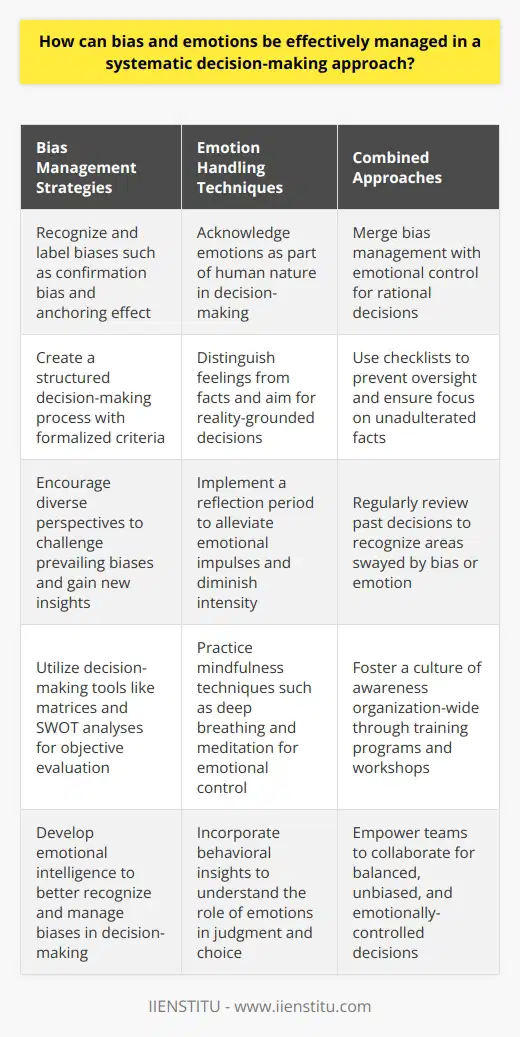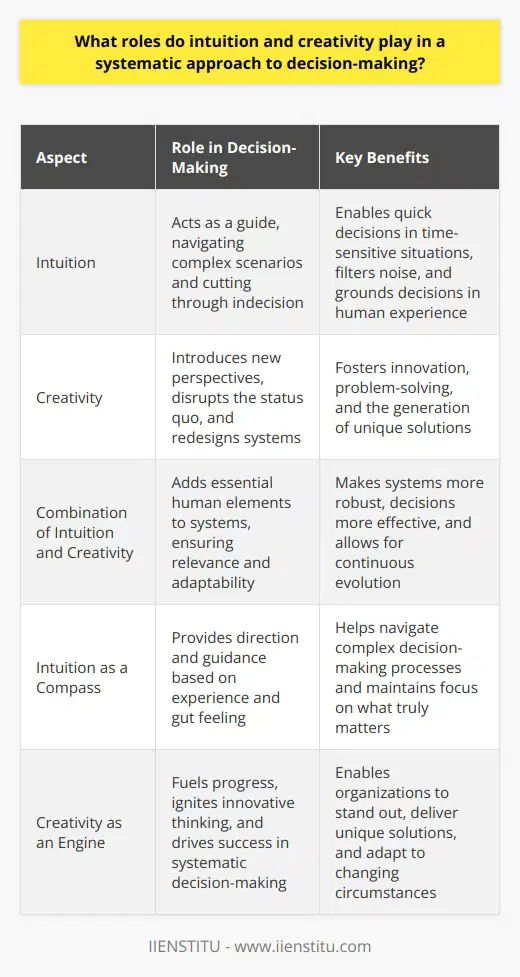
In today's fast-paced and ever-changing world, the ability to make effective decisions quickly is not just a valuable skill—it's absolutely critical. I remember a time when I was working on a project that seemed overwhelmingly complex. There were so many variables and possible outcomes that I felt completely lost. It was like staring into a tangled web with no clear starting point. But then, I discovered the power of systematic thinking, and it transformed not only how I approached that project but also how I tackled challenges thereafter.
Embracing Systematic Thinking
So, what exactly is systematic thinking? At its core, systematic thinking is a structured and methodical way of approaching problems and making decisions. Instead of jumping to conclusions or acting on impulse, it involves breaking down complex issues into smaller, more manageable components. This method allows us to gather and analyze relevant data and follow a logical, step-by-step process to arrive at a well-thought-out solution.
Defining the problem or goal clearly and specifically
Gathering and organizing relevant information
Breaking down the problem into smaller, more manageable parts
Analyzing the data objectively and thoroughly
Generating and evaluating potential solutions
Implementing the chosen solution and monitoring its effectiveness
The Key Principles of Systematic Thinking
To truly harness the power of systematic thinking, it's essential to understand its fundamental principles:
Improved accuracy and reliability: By basing decisions on objective data and logical reasoning, rather than gut instinct or assumptions, systematic thinking helps ensure that our conclusions are sound and reliable.
Greater efficiency: A structured, step-by-step approach eliminates wasted time and effort, allowing us to arrive at solutions more quickly and with less frustration.
Enhanced creativity: While it may seem counterintuitive, the constraints and structure of systematic thinking can actually boost creativity by forcing us to consider new perspectives and possibilities.
Increased confidence: With a clear, logical process to follow, we can approach even the most complex problems with a sense of confidence and control.
In the business world, companies like Toyota have used systematic thinking to revolutionize manufacturing processes, resulting in unparalleled efficiency and quality control.
In the field of medicine, doctors and researchers rely on systematic reviews and meta-analyses to synthesize vast amounts of data and arrive at evidence-based treatment recommendations.
Even in our personal lives, applying systematic thinking to challenges like financial planning or career decisions can help us make more informed, effective choices.
1- Define the problem or goal clearly and specifically.
2- Gather and organize relevant information.
3- Break down the problem into smaller, manageable parts.
Resistance to change: In organizations or teams accustomed to more intuitive or ad-hoc approaches, introducing systematic thinking can be met with resistance or skepticism.
Cognitive biases: Even with a structured process, our own biases and assumptions can still influence our thinking and decision-making.
Time constraints: In fast-paced, high-pressure situations, the time required for a thorough, systematic approach may feel like a luxury we can't afford.
4- Analyze the data objectively and thoroughly.
5- Generate and evaluate potential solutions.
6- Implement the chosen solution and monitor its effectiveness.
By adhering to these principles, we can approach even the most daunting challenges with a sense of order and control. It's like having a roadmap that guides us through the intricate maze of complex problems.
Start small: Begin by applying systematic thinking to relatively simple, low-stakes problems to build confidence and familiarity with the process.
Embrace iteration: Recognize that even the most thorough, systematic approach may not yield a perfect solution on the first try. Be willing to iterate and refine as needed.
Foster collaboration: Systematic thinking is often most effective when done in a team setting, where diverse perspectives and expertise can be brought to bear on a problem.
Continuously learn and adapt: Stay open to new ideas, tools, and approaches that can enhance and streamline your systematic thinking process.
The Benefits of Systematic Thinking
Use visual aids like flowcharts, mind maps, or decision trees to break down complex problems and illustrate your thinking process.
Set clear, measurable goals and success criteria upfront to guide your analysis and decision-making.
Seek out diverse perspectives and actively challenge your own assumptions and biases.
Regularly reflect on and assess the effectiveness of your systematic thinking process, and make adjustments as needed.
You might be wondering, "Why should I bother with systematic thinking?" Trust me, I asked myself the same question until I experienced the benefits firsthand.
Improved Accuracy and Reliability
By basing decisions on objective data and logical reasoning—rather than gut instinct or assumptions—systematic thinking helps ensure that our conclusions are sound and reliable. It's like building a house on a solid foundation rather than shaky ground.
Greater Efficiency
A structured, step-by-step approach eliminates wasted time and effort. Instead of floundering around aimlessly, we can arrive at solutions more quickly and with less frustration. This efficiency is invaluable, especially when time is of the essence.
Enhanced Creativity
While it may seem counterintuitive, the constraints and structure of systematic thinking can actually boost creativity. By forcing us to consider new perspectives and possibilities, we often uncover innovative solutions we might have otherwise overlooked.
Increased Confidence
With a clear, logical process to follow, we can approach even the most complex problems with a sense of confidence and control. Knowing that we have a reliable method reduces anxiety and makes decision-making less intimidating.
Real-World Examples
Systematic thinking isn't just a theoretical concept—it's a practical tool used by successful individuals and organizations worldwide.
Business Innovation: Optimizing Supply Chain Management Process Tips
In the business world, companies like Toyota have revolutionized manufacturing processes through systematic thinking. Their Toyota Production System is a prime example of how a structured approach can lead to unparalleled efficiency and quality control. By meticulously analyzing each step of the production process, they identified areas for improvement, eliminated waste, and optimized their supply chain management. This approach isn't limited to large corporations; even small businesses can apply these optimize supply chain management process tips to enhance productivity.
Medical Advancements
In the field of medicine, doctors and researchers rely on systematic reviews and meta-analyses to synthesize vast amounts of data. This method allows them to arrive at evidence-based treatment recommendations. For instance, the development of standardized treatment protocols for diseases like cancer has been possible due to systematic thinking.
Personal Life Applications
Even in our personal lives, applying systematic thinking to challenges like financial planning or career decisions can help us make more informed and effective choices. When I started using a structured approach to manage my finances, I noticed a significant improvement in my savings and investments.
Overcoming Obstacles and Limitations
Of course, no approach is perfect, and systematic thinking is no exception. Some common challenges include:
Resistance to change: Introducing systematic thinking in organizations accustomed to intuitive approaches can be met with skepticism.
Cognitive biases: Our own biases and assumptions can still influence our thinking, even with a structured process.
Time constraints: In high-pressure situations, the time required for a thorough approach may seem like a luxury.
Tackling Resistance to Change
Change is often met with resistance, especially when it challenges long-standing habits. To overcome this:
Communicate the benefits: Clearly explain how systematic thinking can improve outcomes.
Provide training: Equip team members with the necessary skills and tools.
Lead by example: Demonstrate the effectiveness through small wins.
Addressing Cognitive Biases
Awareness is the first step in overcoming biases. Techniques such as:
Seeking diverse perspectives
Challenging assumptions
Implementing checks and balances
can help mitigate the impact of biases on decision-making.
Managing Time Constraints
While systematic thinking can be time-consuming, it's possible to streamline the process:
Prioritize key steps: Focus on the most critical components.
Utilize tools and software: Leverage technology to speed up data analysis.
Develop quick reference guides: Create templates to expedite the process.
Strategies for Success
So, how can we set ourselves up for success with systematic thinking? Here are a few key strategies that have worked for me:
Start Small
Begin by applying systematic thinking to relatively simple, low-stakes problems. This approach helps build confidence and familiarity with the process without overwhelming you.
Embrace Iteration
Recognize that even the most thorough approach may not yield a perfect solution on the first try. Be willing to iterate and refine as needed. This iterative process is a cornerstone of methodologies like Agile and Lean.
Foster Collaboration
Systematic thinking is often most effective when done in a team setting. Diverse perspectives and expertise can enrich the analysis and lead to more robust solutions. Collaboration not only enhances the quality of decisions but also promotes buy-in from team members.
Continuously Learn and Adapt
Stay open to new ideas, tools, and approaches that can enhance your systematic thinking process. The world is constantly evolving, and so should our methods. Continuous improvement is key to long-term success.
Practical Tips to Enhance Systematic Thinking
To put these strategies into action, consider the following practical tips:
Use Visual Aids: Tools like flowcharts, mind maps, or decision trees can help break down complex problems and illustrate your thinking process. Visual representations make it easier to comprehend and communicate ideas.
Set Clear, Measurable Goals: Define success criteria upfront to guide your analysis and decision-making. Knowing what you're aiming for keeps you focused and aligned.
Seek Diverse Perspectives: Actively challenge your own assumptions and biases by consulting others. Diverse input can reveal blind spots and generate innovative solutions.
Reflect Regularly: Periodically assess the effectiveness of your systematic thinking process, and make adjustments as needed. Reflection fosters growth and improvement.
Document Your Process: Keep records of your steps and decisions. Documentation not only provides a reference but also helps in reviewing and learning from past experiences.
The Role of Systematic Thinking in Supply Chain Management
Bringing it back to the business context, let's delve deeper into how systematic thinking plays a pivotal role in optimizing supply chain management. In a globalized economy, supply chains have become incredibly complex, involving numerous stakeholders, regulations, and logistical challenges.
Applying Systematic Thinking to Streamline Processes
By applying systematic thinking, organizations can:
Identify Bottlenecks: Analyze each stage to pinpoint delays or inefficiencies.
Enhance Coordination: Foster better communication between suppliers, manufacturers, and distributors.
Improve Forecasting: Use data-driven methods to predict demand and adjust supply accordingly.
Reduce Costs: Eliminate wasteful practices and optimize resource utilization.
Tips for Optimizing Supply Chain Management
Here are some practical optimize supply chain management process tips:
1- Map Out the Entire Supply Chain: Understand every link in the chain to identify interdependencies.
2- Implement Technology Solutions: Use software for real-time tracking and data analytics.
3- Establish Strong Relationships: Build trust and open communication with suppliers and partners.
4- Regularly Review and Adjust: Continuously monitor performance and adapt to changes.
5- Invest in Training: Equip your team with the skills needed for efficient supply chain management.
By integrating systematic thinking into these areas, businesses can achieve greater resilience and agility.
Conclusion
In a world that often feels chaotic and unpredictable, systematic thinking offers a powerful tool for navigating complexity and making sound, effective decisions. By breaking down problems into manageable parts, gathering and analyzing relevant data, and following a structured process, we can approach even the most daunting challenges with clarity and confidence.
Reflecting on my own journey, I can attest to the transformative impact of embracing systematic thinking. It not only improved my problem-solving skills but also enhanced my creativity and confidence. Of course, systematic thinking is not a panacea—it requires ongoing practice, reflection, and refinement. But by embracing the principles and strategies outlined here, and by staying open to continuous learning and growth, we can all harness the power of systematic thinking.
Whether you're looking to optimize supply chain management processes, make better personal decisions, or drive innovation in your field, systematic thinking can be your guiding compass in an ever-changing world.
References
Kahneman, D. (2011). Thinking, Fast and Slow. Farrar, Straus and Giroux.
Senge, P. M. (1990). The Fifth Discipline: The Art & Practice of The Learning Organization. Doubleday.
Liker, J. K. (2004). The Toyota Way: 14 Management Principles from the World's Greatest Manufacturer. McGraw-Hill.
Goldratt, E. M., & Cox, J. (1984). The Goal: A Process of Ongoing Improvement. North River Press.
Meadows, D. H. (2008). Thinking in Systems: A Primer. Chelsea Green Publishing.
Frequently Asked Questions
What are the key elements of a systematic approach in efficient decision-making?
A Structured Path to Sound Decisions
Efficient decision-making requires a robust, systematic approach. At its core are several key elements that guide an individual or organization through the maze of potential choices to a clear, rational conclusion. Embracing these elements can vastly improve outcomes, ensuring decisions are well-informed and aligned with overarching goals.
Define Clear Objectives
Begin with objectives. Before one can decide, one must understand what success looks like. Objectives guide the decision-making process, providing clear targets to reach.
Gather Data
Gathering data is next. Decisions should rest on solid ground. This means collecting relevant, high-quality information about the options available. This data serves as the foundation for all subsequent analysis.
Analyze the Options
Once you have data, analyze it. Compare each option against your objectives. Searching for trade-offs and synergies among different choices is crucial. This analysis should reveal the strengths and weaknesses of each option.
Develop Alternatives
Always develop alternatives. A systematic approach demands flexibility; creating a list of potential courses of action allows decision-makers to consider multiple pathways to success.
Assess Risks
Risks need assessment too. Every decision comes with its own set of risks. Identifying and evaluating these dangers helps to anticipate potential problems and, when possible, avoid them.
Make a Decision
Now, make a decision. After thorough analysis and risk assessment, one should possess enough insight to make an informed choice.
Implement the Decision
Implementation follows. Putting the decision into action requires planning and resources. Prepare to execute the chosen option effectively.
Evaluate Outcomes
Finally, evaluate outcomes. Reflection is crucial. Assess the results of the decision compared to the initial objectives set. This critical evaluation feeds back into the cycle, providing valuable insights for future decisions.
In conclusion, a systematic approach to decision-making may appear complex, but it ensures thoroughness and objectivity. It reduces mistakes, clarifies reasoning, and upholds integrity throughout the decision-making process. Adhering to these structured steps can vastly enhance the efficiency and effectiveness of any decision made, whether by individuals or organizations.

How can bias and emotions be effectively managed in a systematic decision-making approach?
Understanding Bias and Emotions
In decision-making, biases and emotions loom large. They often steer judgments unconsciously. Recognizing their presence is crucial. It marks the first step toward effective management.
Strategies for Managing Bias
Recognize and Label Biases
Begin by identifying common biases. Confirmation bias and anchoring effect are examples. They influence how information is interpreted.
Create a Structured Decision-Making Process
Formalize decision criteria beforehand. This minimizes on-the-spot, biased reasoning. Such a process relies on facts, not instincts.
Encourage Diverse Perspectives
Seek input from varied sources. Different viewpoints can challenge prevailing biases. This opens doors to new, unbiased insights.
Use Decision-Making Tools
Decision matrices and SWOT analyses help. Such tools ensure objective evaluation. They sideline bias in favor of structured assessment.
Handling Emotions in Decisions
Acknowledge Emotions
First, admit emotions influence decisions. They are part of human nature. Denial only intensifies their impact.
Distinguish Feelings from Facts
Separate emotional reactions from objective information. Ask, "What is truth, and what is feeling?" Aim for decisions grounded in reality.
Implement a Reflection Period
Pause before finalizing decisions. Reflection alleviates emotional impulses. Time can diminish emotional intensity.
Practice Mindfulness Techniques
Mindfulness fosters emotional control. Deep breathing and meditation offer benefits. They soothe the mind for clearer thinking.
Combining Both Approaches
Merge bias management with emotional control. Tackle both to ensure rational decisions. Together, they guide toward a systematic approach.
Use Checklists
Checklists prevent oversight. They serve as reminders for unadulterated facts. Ensure they include points to negate bias and emotion.
Regularly Review Decisions
Assess past decisions for improvement areas. Recognize where bias or emotion swayed you. Use these learnings for future decisions.
Foster a Culture of Awareness
Encourage this dual approach organization-wide. Emphasize its importance continually. Training programs and workshops can instill these practices.
- Develop Emotional Intelligence
- Incorporate Behavioral Insights
- Empower Teams for Balanced Decision-Making
Conclusion
Effectively managing bias and emotions is intricate. It requires dedication and continual practice. Yet, it is obtainable through structured approaches. They guide us toward more enlightened decision-making.

What roles do intuition and creativity play in a systematic approach to decision-making?
The Interplay of Intuition and Creativity
Intuition in Decision-Making
Intuition acts as a guide. It helps navigate complex scenarios. It often stems from experience. Over time, professionals develop a gut feeling. This feeling cuts through indecision. It swiftly homes in on potential solutions.
Intuition does not always rely on conscious reasoning. It can, however, lead to quick decisions. These decisions prove pivotal in time-sensitive situations. Especially when data overload paralyzes the decision-making process. Here, intuition can filter the noise. It highlights what truly matters.
In a systematic approach, intuition might seem out of place. However, it complements analytics beautifully. It offers a human touch to cold, hard data. Intuition grounds decisions in human experience. It ensures decisions resonate on a human level.
Creativity as a Systematic Component
Creativity thrives on originality. It introduces new perspectives. Without it, systems might churn out predictable, ineffective solutions. Creativity brings innovation into the equation. It disrupts the status quo. It asks "What if?".
Creativity can redesign systems. It paves the way for improvement. It invites unorthodox methods. These methods can revolutionize decision-making practices. They help organizations stand out. They deliver unique solutions to worn-out problems.
In challenging situations, creativity saves the day. It can see connections where others see dead ends. It fosters problem-solving. It generates a breadth of ideas. From these, systems can select the most promising ones.
Bringing It All Together
Intuition and creativity work in tandem. Both add essential human elements to systems. They help maintain relevance. They adapt to changing circumstances. They ensure systems do not become obsolete.
Intuition adds speed and relatability. Creativity adds breadth and innovation. Together, they make systems more robust. They make decisions more effective. They allow systems to evolve.
Decision-making that incorporates both thrives. It blends wisdom with ingenuity. It mixes experience with daring. These elements should not be at odds. They should unite to create superior outcomes.
- Intuition acts as a trusty compass.
- Creativity fuels the engine of progress.
Ultimately, systems need both. They require the gut feeling that directs. They need the creative spark that ignites. This combination drives success in systematic decision-making.



